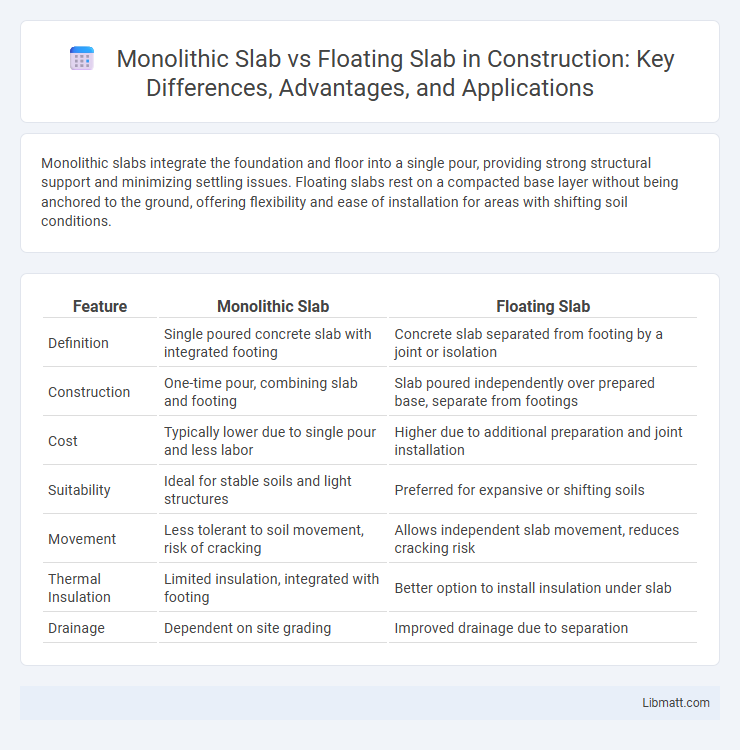Monolithic slabs integrate the foundation and floor into a single pour, providing strong structural support and minimizing settling issues. Floating slabs rest on a compacted base layer without being anchored to the ground, offering flexibility and ease of installation for areas with shifting soil conditions.
Table of Comparison
| Feature | Monolithic Slab | Floating Slab |
|---|---|---|
| Definition | Single poured concrete slab with integrated footing | Concrete slab separated from footing by a joint or isolation |
| Construction | One-time pour, combining slab and footing | Slab poured independently over prepared base, separate from footings |
| Cost | Typically lower due to single pour and less labor | Higher due to additional preparation and joint installation |
| Suitability | Ideal for stable soils and light structures | Preferred for expansive or shifting soils |
| Movement | Less tolerant to soil movement, risk of cracking | Allows independent slab movement, reduces cracking risk |
| Thermal Insulation | Limited insulation, integrated with footing | Better option to install insulation under slab |
| Drainage | Dependent on site grading | Improved drainage due to separation |
Introduction to Monolithic and Floating Slabs
Monolithic slabs are poured as a single continuous concrete element combining the foundation and floor slab, providing uniform strength and stability ideal for simpler constructions. Floating slabs, on the other hand, rest on compacted gravel without being anchored to the ground, allowing slight movement to accommodate soil expansion or contraction. Understanding the differences between monolithic and floating slabs helps you choose the best foundation type for your building's soil conditions and structural needs.
What is a Monolithic Slab?
A monolithic slab is a single, continuous concrete foundation that combines the footing and slab into one pour, providing uniform strength and stability. This type of foundation is commonly used in residential construction for its simplicity and cost-effectiveness, especially in areas with stable soil conditions. Monolithic slabs reduce labor and material costs by eliminating the need for separate footings, making them ideal for small to medium-sized structures.
What is a Floating Slab?
A floating slab is a type of concrete foundation poured directly on the ground without deep footings, designed to "float" independently of the soil beneath. Unlike monolithic slabs, floating slabs are not rigidly connected to the foundation walls, allowing for slight movement and reducing cracking risks in areas with expansive or shifting soils. This design is commonly used for garages, sheds, and patios due to its cost-effectiveness and flexibility in accommodating ground movement.
Key Differences Between Monolithic and Floating Slabs
Monolithic slabs combine the foundation and floor slab into a single pour, offering enhanced structural integrity and cost efficiency by minimizing construction stages. Floating slabs rest independently on a prepared base without being anchored to the ground, allowing for movement and reducing the risk of cracking in expansive soils. The key differences revolve around installation method, ground interaction, and suitability for varying soil conditions, with monolithic slabs favored in stable soils and floating slabs preferred where ground movement is anticipated.
Construction Process of Monolithic Slabs
Monolithic slab construction involves pouring the foundation and floor slab simultaneously in a single, continuous operation, which minimizes labor time and reduces potential joints that can cause cracking. This process requires precise coordination of formwork, reinforcement placement, and concrete pouring to ensure structural integrity and durability. Your project benefits from this efficient method by achieving a strong, uniform base with fewer construction phases compared to floating slab installation.
Construction Process of Floating Slabs
The construction process of floating slabs involves pouring concrete directly onto a prepared sub-base without anchoring it to the ground, allowing the slab to move independently of the soil. This method includes installing a moisture barrier and reinforcement mesh, followed by precise leveling to ensure structural integrity and reduce cracking. Floating slabs are often used in garages and patios where ground movement or slight shifting is anticipated, offering flexibility and durability.
Pros and Cons of Monolithic Slabs
Monolithic slabs offer the advantage of combining the foundation and floor into a single concrete pour, reducing construction time and labor costs while enhancing structural integrity against soil movement. However, they can be susceptible to cracking if the soil shifts or settles unevenly, and repairs often require cutting into the slab, which can be costly and disruptive. If your project requires a simple, cost-effective foundation with minimal excavation, a monolithic slab may be suitable, but consider soil conditions carefully to avoid long-term maintenance issues.
Pros and Cons of Floating Slabs
Floating slabs offer advantages such as cost-effectiveness, easier installation, and adaptability to minor ground movement, making them ideal for patios, garages, and sheds. However, floating slabs have limitations including susceptibility to cracking in expansive soils, less structural support compared to monolithic slabs, and potential moisture penetration if not properly sealed. Choosing a floating slab requires weighing its flexibility and affordability against durability and load-bearing capacity concerns.
Cost Comparison: Monolithic Slab vs Floating Slab
Monolithic slabs typically cost less than floating slabs due to their simplified construction process combining the foundation and slab into a single step, reducing labor and material expenses. Floating slabs require additional materials and labor for control joints and isolation techniques, increasing overall costs. Budget considerations often favor monolithic slabs for smaller projects or stable soil conditions, while floating slabs may justify their higher cost in environments prone to ground movement.
Choosing the Right Foundation: Factors to Consider
When selecting between a monolithic slab and a floating slab, key factors include soil type, load requirements, and climate conditions affecting expansion and contraction. Monolithic slabs provide a single uniform pour ideal for consistent load distribution, while floating slabs allow movement and reduce cracking on expansive soils. Assess your site's stability and intended structure use to determine the most suitable foundation for your project's longevity and performance.
Monolithic slab vs floating slab Infographic

 libmatt.com
libmatt.com